Roman - Iron Age - Available - Photo gallery
Image database with photographs of ancient art and antiquities
Our image database provides photographs of ancient art and antiquities for press releases as well as for private use. All artefacts sold in our gallery are documented through professional photographs. The resulting image library contains numerous ancient Egyptian, Greek and Roman antiquities as well as ancient coins. The time span from Stone Age, over Bronze Age and Classical Antiquity until Late Antiquity is covered.The photo gallery aims at providing a vast visual archive equipped with filters and search tools. You are most welcome to search the constantly growing number of artefacts in the image library. We are also happy to authorize hyperlinks from your webpage / forum to the objects depicted in our gallery. For this purpose, please send us a short notification prior to placing a hyperlink. For almost every object high definition photographs are available and can be provided e.g. to document your collection or for scientific papers or popular science articles. If you are interested in using pictures for publications, print media or other purposes, please contact us and we will be happy to assist you.
-
 Rare Roman mosaic glass face bead showing Medusa head
Rare Roman mosaic glass face bead showing Medusa headMosaikglasperle aus einer oströmischen Werkstatt des 1. Jh. n. Chr., möglicherweise ägyptisch oder nubischer Import. Das abgebildete Frauengesicht wird gerne als Darstellung der Medusa gedeutet.
 Roman ritual mirror showing Leda and the swan
Roman ritual mirror showing Leda and the swanDarstellung der Leda, die mit entblößter Brust am Boden liegt. Von der Seite nähert sich der Schwan. Über der Szene zweireihige griechische Inschrift.
 Roman oil lamp from Dr. Steve Adler collection
Roman oil lamp from Dr. Steve Adler collectionMirror decorated with a harbor scene. From the famous Dr. Steve Adler collection. Exported from Israel with IAA permit Nr. 539063.
 Large Roman cinerary urn
Large Roman cinerary urnImpressive jar from the 1st or 2nd century AD. Great condition for ancient glass of this size. 26cm high.
 Very high herm with bust of Dionysos
Very high herm with bust of DionysosAn almost identical, however less well preserved herm in on exhibition in the J. Paul Getty Museum. From the Austrian collection of Prof. Ritschel, carrier of the Large Cross of Honor of the Austrian Republic and many other prizes and honors.
 Two mosaic glass beads
Two mosaic glass beadsNicely decorated miniature works of art. Outstanding examples for mosaic glass beads from the early Roman Imperial period.
 Three mosaic glass beads
Three mosaic glass beadsMiniature works of art with different decorations. Fantastic examples for mosaic glass beads from the early Roman Imperial period.
 Side frame of a Roman stool
Side frame of a Roman stoolPiece of a seating furniture with elaborate openwork designs. The fantastic state of preservation is known from other bronze stools found in Pompeii and the area around Mount Vesuvius.
 Mosaic glass inlay with half mask
Mosaic glass inlay with half maskSkillfully arranged motif that could be combined with a plate of the same motif to show a full face. Made in Egypt during the early Roman Imperial period.
 Roman marble relief with hunting scene: Eros carrying hind
Roman marble relief with hunting scene: Eros carrying hindSupposedly from the collection of the Swiss painter Arnold Böcklin (1827-1901). Very good condition, surface very well preserved.
 Extremely fine Marc Antony Denarius - LEG XI
Extremely fine Marc Antony Denarius - LEG XIBeautiful dark patina. Commemorating the Legio XI formed by M. Anton, while a Legio XI Actiaca fought in the Actium campaign serving Octavian.
 Roman gold fingerring
Roman gold fingerringNice piece of jewellery from the later Roman Imperial period. With beaded wires and intaglio. Found in England.
 Female stone portrait head
Female stone portrait headHellenistic Greece or Egypt under Roman rule. From the Austrian collection of Prof. Ritschel, carrier of the Large Cross of Honor of the Austrian Republic and many other prizes and honors.
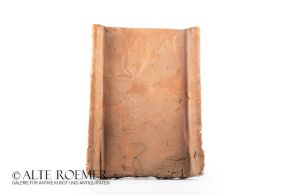 Large Roman roof tile from the Rhineland
Large Roman roof tile from the RhinelandWith loop-shaped mark. Found near the Roman city of Novaesium, today's Neuss in Germany, an early Roman foundation and with this one of the oldest cities in Germany.
 Very rare large Samian Ware hunt cup
Very rare large Samian Ware hunt cupThe barbotine decoration is masterly made and excellently preserved. Absolutely worth the exhibition in a museum. A similar piece is on exhibition in the British Museum in London. Ex Vienna Schönbrunn Gallery, acquired 1986. With TL analysis.
 Mosaic glass inlays and spindle whorls
Mosaic glass inlays and spindle whorlsNice group of polychrome inlays and spindle weights from Roman Egypt. Including two fragments with a wonderful floral decor.
 Pair of Roman earrings from Syria
Pair of Roman earrings from SyriaExtremely skillfully crafted jewellery with wonderful granulation. The design points to Syria during the Late Roman Imperial period.
 Base plate of a Roman mirror
Base plate of a Roman mirrorPerfectly preserved bronze plate of a Roman mirror. A handle and reflective metal coating were once part of the object. Typical for upper class Roman households during Imperial times.
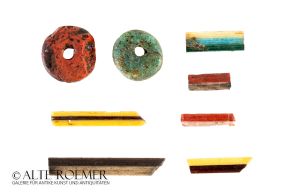 Roman-Egyptian glass inlays and spindle whorls
Roman-Egyptian glass inlays and spindle whorlsNice group of polychrome inlays and spindle weights from Roman Egypt. From an old English collection, ex Bonhams London.
 Cicero - very rare German 1535 edition with 234 partially page-large woodcuts
Cicero - very rare German 1535 edition with 234 partially page-large woodcutsThe only 1535 edition currently available on the market known to us. Very good condition, appropriate for the age of the volume. Especially worth mentioning are the rich illustrations showing Death as Grim Reaper, feasts, a woman giving birth with midwife, and a scholar wearing glasses.
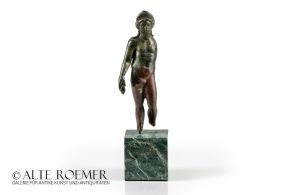 Roman bronze Apollo Kitharoidos - ex Christie's
Roman bronze Apollo Kitharoidos - ex Christie'sImpressive, very aesthetic figure. Excellently preserved with beautiful patina. Mounted on modern green marble base.
 Roman glass juglet with trailing
Roman glass juglet with trailingThe elegant vessel is a magnificent example of the mature art of glass making in the Roman Empire during Late Antiquity. From the collection of the well-known archaeologist Professor Fritz Fremersdorf.
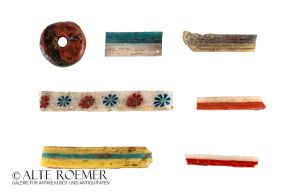 Mosaic glass inlays and spindle whorl
Mosaic glass inlays and spindle whorlNice group of polychrome inlays and a spindle weight from Roman Egypt. Including one fragment with a wonderful floral decor.
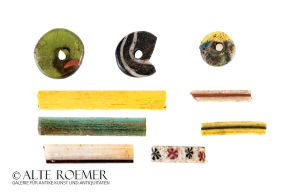 Mosaic glass inlays and spindle whorls
Mosaic glass inlays and spindle whorlsNice group of polychrome inlays and spindle weights from Roman Egypt. Including one fragment with a wonderful floral decor.
 Roman appliqués of Sol Invictus and Luna
Roman appliqués of Sol Invictus and LunaEnsemble of two nice terra cotta examples of the cult around the Roman sun god and moon goddess in Roman Imperial times.
 Extremely fine Julius Caesar denarius
Extremely fine Julius Caesar denariusNice patina. Ex NAC Zürich, auction 25, 2003. Most likely minted to pay Caesar's troops after the victory at the Battle of Thapsus (North Africa, modern Tunis).
 Roman glass bottle with beautiful colour bands
Roman glass bottle with beautiful colour bandsA colourful ancient glass from the early 1st century. Made in the Eastern Mediterranean.
 Glass double unguentarium
Glass double unguentariumImpressive cosmetic vessel with large handle and nice spiral trailing decoration. A Palestinian type from the Late Roman or Early Byzantine period.
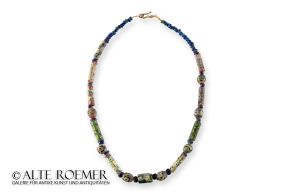 Necklace of Egyptian mosaic glass beads
Necklace of Egyptian mosaic glass beadsModernly threaded necklace of ancient beads of spherical and cylindrical shape made of beautiful mosaic glass. From a workshop in Roman Egypt. Ex Christie's.
 Eastern Roman glass bottle with thread decoration
Eastern Roman glass bottle with thread decorationA product from the Roman province of Palaestina. The high-quality glass was created in the 6th to early 7th centuries, when the Eastern Roman Empire was thriving and the Byzantine Empire took shape.
 Late Roman glass vessel with thread decoration
Late Roman glass vessel with thread decorationA product from the province of Palaestina or Syria. The high-quality glass was created in the 4th or early 5th century, a time of upheaval for the Roman Empire.
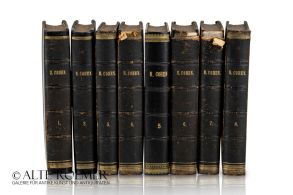 Very rare Henry Cohen 1880 - 1892 edition
Very rare Henry Cohen 1880 - 1892 editionDeuxième Édition. Paris - London 1880 - 1892. Contemporary half-leather binding with golden letterae. A highlight for every numismatics literature collection.
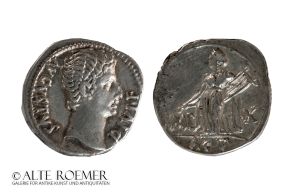 Extremely fine Augustus denarius commemorating Battle of Actium
Extremely fine Augustus denarius commemorating Battle of ActiumThis issue commemorates the victory of Octavian (Augustus) over Mark Antony and Cleopatra at the Battle of Actium in 31 B.C.
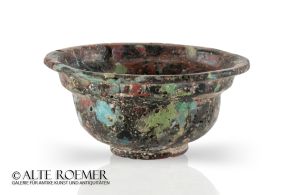 Roman glass mosaic bowl
Roman glass mosaic bowlNice little bowl with an abstract colourful design. Dating to the early Roman Imperial period. With Italian export permit.
 Roman marble head of a woman - ex Duke University of Art Museum
Roman marble head of a woman - ex Duke University of Art MuseumBeautiful, life-size portrait. The provenance can be reconstructed until 1920, when the portrait was acquired from Jannis Demetrios Mikas by Ernest Brummer, both famous collectors.
 Roman bowl of colourful ribbon glass
Roman bowl of colourful ribbon glassThe bowl was made in mosaic glass technique. It is truely a work of art and a showpiece for the glass production in the Roman core region during the Early Imperial period.

